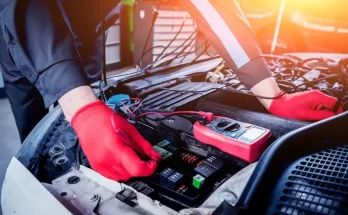Myths About Electric Vehicle Maintenance—Debunked in 2025
As electric vehicles (EVs) surge into the mainstream, their presence on roads around the globe is becoming impossible to ignore. From sleek sedans to powerful pickups, EVs are no longer niche products—they’re the future of transportation. But despite this rapid adoption, misconceptions about EV maintenance persist. Many drivers remain hesitant, clinging to outdated beliefs about costs, complexity, and reliability.
In 2025, it’s time to set the record straight. Here are the most common myths about electric vehicle maintenance—debunked once and for all.
Myth 1: EVs Require More Maintenance Than Gas-Powered Cars
Truth: Electric vehicles actually require less maintenance.
Traditional internal combustion engine (ICE) vehicles have hundreds of moving parts that need regular care—spark plugs, timing belts, oil filters, and more. In contrast, EVs use electric motors with far fewer components. There’s no engine oil to change, no transmission fluid to worry about, and no exhaust systems that can rust or fail. For most EV owners, routine check-ups are more about tire rotations and software updates than mechanical fixes.
Myth 2: Battery Replacements Are Frequent and Expensive
Truth: EV batteries are built to last—and warranties back that up.
One of the biggest fears among potential EV buyers is the idea that the battery will degrade quickly and need replacing every few years. In reality, EV batteries are engineered for longevity. Most manufacturers offer battery warranties that cover 8 to 10 years or 100,000 to 150,000 miles. Many owners report little noticeable degradation even after five or more years of use.
With advances in battery chemistry and thermal management systems in 2025, EVs are more reliable than ever. For most drivers, a well-maintained EV battery can last the lifetime of the vehicle.
Myth 3: EV Repairs Require Specialized, Hard-to-Find Mechanics
Truth: EV service options are expanding rapidly.
It’s true that EVs require different knowledge than traditional cars, but that doesn’t mean service is out of reach. In fact, more automotive technicians are receiving EV-specific training than ever before. From dealerships to independent shops, qualified EV mechanics are becoming the norm, not the exception.
Additionally, many EVs feature over-the-air (OTA) updates, allowing software fixes without even visiting a shop. Tesla pioneered this, but in 2025, nearly all major EV manufacturers offer similar capabilities.
Myth 4: Regenerative Braking Is a Gimmick That Causes Extra Wear
Truth: Regenerative braking reduces wear on brake components.
This system, which converts kinetic energy back into electricity during braking, is standard in most EVs. Some critics worry it’s just a flashy feature that leads to higher brake repair costs.
Myth 5: Software Updates Are Optional and Unimportant
Truth: Software is at the heart of EV performance and safety.
Unlike ICE vehicles, where software plays a minor role, EVs are essentially computers on wheels. Software updates improve efficiency, fix bugs, enhance driver-assistance features, and sometimes even increase battery range or performance.
Skipping these updates is akin to ignoring a recall in a traditional car. In 2025, keeping your EV’s software current is just as important as inflating your tires or changing your air filter.
Myth 6: EVs Struggle in Extreme Climates
Truth: Modern EVs are designed to handle heat and cold with ease.
Early EVs did face challenges with range and performance in extreme temperatures, especially in freezing conditions. But that’s no longer the case. Improved battery management systems, heat pumps, and insulated battery packs have significantly mitigated these issues.
In cold climates, features like preconditioning (warming the battery before driving) help maintain efficiency. In hot climates, advanced cooling systems prevent overheating.
Myth 7: Home Charging Is Complicated and Expensive
Truth: Charging at home is simple—and often cheaper than fueling up.
Many people believe home charging requires expensive infrastructure or technical know-how. In reality, most EV owners install a Level 2 charger using a standard 240-volt outlet, much like what a dryer uses. Installation costs vary but can often be offset by government incentives or tax credits.
Once installed, charging at home becomes second nature. Plug in overnight, and your car is ready each morning—no gas station visits required. And depending on your electricity rates, charging at home can be 70% cheaper than gasoline.
Myth 8: EVs Are Too New to Trust for the Long Haul
Truth: EVs have proven their reliability—and the future is only getting better.
Electric vehicles have been around for over a decade now, with millions of them on the road globally. Brands like Tesla, Nissan, and Chevrolet have logged billions of miles of real-world data. Failures and recalls are statistically lower in EVs than in ICE vehicles.
As of 2025, we’re seeing EVs routinely surpass 200,000 miles with minimal issues. Their simplicity, combined with fewer fluids and moving parts, leads to longer lifespans and lower total cost of ownership.
Final Thoughts: EV Maintenance Is Easier Than You Think
As we look toward an increasingly electrified future, understanding the realities of EV ownership becomes essential. Maintenance myths are fading as more drivers experience the benefits firsthand: lower costs, less hassle, and greater reliability.
If you’re still on the fence about going electric because of maintenance concerns, 2025 is the year to reconsider. The evidence is clear: EVs aren’t just better for the planet—they’re also better for your wallet and your time.




